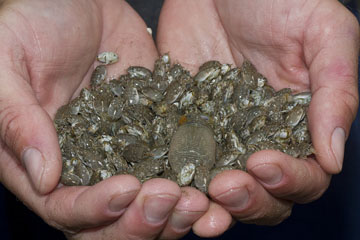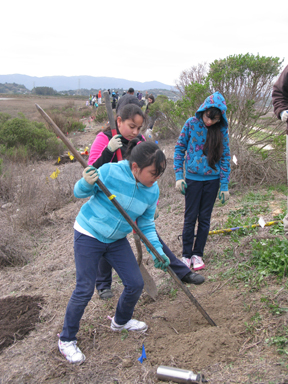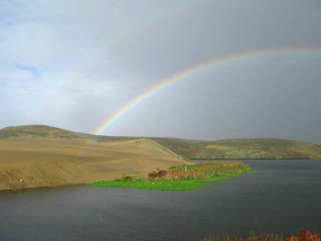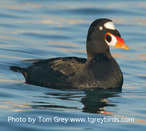Comparisons fail; opposites tumble together into the same thing; emotions collide.
On August 1st we walk the path to Abbotts Lagoon, eager for anything we might encounter, glad to be alive. We are three friends, almost alone in the landscape on a weekday morning. The marine layer is overhead – a soft fog-overcast.
Everything along the way is fine, excellent. At the lower lagoon we are met by a lively assembly of white pelicans and Caspian terns, cormorants gulls ravens and more birds. The sand-dune garden is alive with color and texture.
Then we arrive at the ocean’s edge, where a bizarre number of boats are fishing just offshore and some vultures are attending to a dead pinniped farther along the beach. Our glad wonder persists, even as we inspect the multiple windrows of textured white along the high-tide line: countless tiny exoskeletal bits, bleached and braided into ribbons curving into the distance, dotted with by-the-wind-sailers that are mostly cleaned to cellophane sailboats.
Then we go wading into the waves’ edge, to feel the water oddly warmed by the early strong arrival of the southerly countercurrent. And behold! Come toe to toe with a novel, ultimately perturbing event in the life of the littoral. Our feet detect this phenomenon as we sink up to our ankles into the saturated coarse-grained sand that tumbles in the steep swash* zone along Point Reyes’ great beach. Movement! Tickle! A swarm of living beings agitates among and across our tarsals and metatarsals. Yelps are uttered, and a quick hop executed to free feet from the matrix of... sand crabs. Tiny ones, a thick multitude tumbling about as they try to regain purchase inside the substrate, so many and so small, and evidently at the mercy of a terrifying habitat.
For a while we mess with them, first in marvel and delight, then becoming steadily dumbfounded at the magnitude of this miniscule-mole-crab event. A double handful of sand lifted from the swash seems to yield more tiny crustaceans than sand, by volume. Once set back down, the little beings wave their parapods about and then just lie there, unable to get right with their place. So we try to smooth sand over them, generally succeeding only in revealing a few dozen more individuals to the open air and imminent waves.
Speculation then begins in earnest. What does this hyperabundance of mole crab productivity say about previous generations hatching from beaches into the sea? About the sheer density of these creatures’ larval-stage existence, awash in the California Current? About events in the sea and season that have brought so many, so very very many of them, to the right age and size for settling out on this vigorous, sometimes violent, open-ocean beach. Where they are tumbled and killed and ground up into chunky detritus along the shore, becoming the curvilinear crustacean high-tide memorial.
Point Reyes Beach is ten to thirteen miles long, depending on who’s talking. Standing as we are at its mid-point, the great umbilicus, Abbotts Lagoon, we gaze left and right as if we might calculate the expanse of this mole-crab horde. Let’s see. Ten miles times about two meters (the width of the waves’ wash) times... how many individuals per unit squared? Here the mind stops working.
Instead, it turns to the question why, and our imaginary science keeps rolling out scenarios. Perhaps there’s been a spike in reproductive output here and elsewhere along our coast. Extraordinary survival of larvae in the plankton flow. Off-kilter currents tossing way too many ashore at one time. Not nearly enough predation here and now. (Where are the sanderling willets and godwits? oh right, mostly up north still.)
Pondering all this, as well as the indelible sensation of a struggle going on atop our toes in the watery sand, we waffle between wonder and mild horror ‒ amazement at both the life energy and the death-in-progress here. There is not really capacity inside us for these feelings. So we stop talking and go sort of slack.
Some time later on we are retracing our steps inland, having spent time admiring a truly great egret foraging in the marsh and an otter mater leading two kits along the upper lagoon. The ocean is behind us, the rim of the overcast visible in the east. We talk of Lammas and the turn of the year. Today is a cross-quarter day that marks the time for winnowing and weeding – discarding whatever is in the way of the most abundant harvest. We name what we are bringing to fruition this time ‘round the sun.
Meanwhile, about a half-mile behind us, there is unspeakable winnowing under way in the oceanic year – death in the swash. We try to embrace the dilemma of tiny mole-crab beings weakly struggling to persist. Failing at this, we speak of the nutrients returning to seawater as so many billions of individuals die and dissolve in the soup.
Untold numbers blur into a single organism. A huge pulse of bio-vitality merges with annihilation. Cruel accident conflates with the elegant strategy of mole crabs’ life history. Death is generative. We are aghast and encouraged, all at once. We wonder and we pray.
There will be future walks along a gentler beach, watching as gravid female mole crabs hug their harvests of apricot-colored eggs to their abdomens, only to toss them away when the time is right, releasing them into the surge to renew the potential for another crop.
* Swash is an actual term for the section of a sand beach that is washed by remains of waves. It constantly shifts ‒ with the wave height, shore profile, and tide. Its upper limit is the curving line where sea water stops flowing up the shore and turns to wash back into the sea again. See “The Sand Swimmer” in West Marin Review no. 5, 2014.



